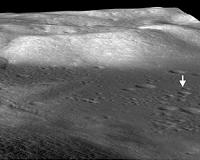 |
Pittsburgh PA (SPX) Aug 24, 2010 Astrobotic Technology, a Carnegie Mellon University (CMU) spin-off company has announced that Caterpillar will be a sponsor its first robotic expedition to the lunar surface. The initial Astrobotic mission will revisit the Apollo 11 site in April 2013 with a five-foot tall, 160-lb. robot broadcasting 3D high-definition video. The mission will carry payloads to the Moon and convey the experience to the world via Internet video access. The expedition also will claim a financial trifecta: up to $24 million in the Google Lunar X Prize, a $10 million data sale to NASA, and Florida's $2 million bonus for launching from that state. In 2007 Caterpillar sponsored Carnegie Mellon's winning machine in the Urban Challenge, a competition for autonomous vehicles conducted by DARPA, the Defense Advanced Research Projects Agency. The sensors and code base developed for this race of driverless cars through city traffic are evolving into the guidance and control for the spacecraft that will take Astrobotic's robot to the lunar surface. "Caterpillar has enjoyed a successful relationship with Carnegie Mellon University over the last two decades. Our sponsorship of CMU's winning machine in the 2007 Urban Challenge has served as a technology foundation for further work to automate our large mining trucks," said Eric Reiners, Caterpillar Automation Systems Manager. "Our customers are moving to more remote and harsh environments. This drives the need for further development of autonomous and remote operation of equipment. We look forward to applying the technology developed and lessons learned from the Astrobotic expedition toward our own Cat equipment." Carnegie Mellon and Astrobotic have expended more than $3 million creating mission designs and prototype Moon robots engineered to operate during extreme heat - soil temperatures at the lunar equator hit 224 degrees F at noon. "Operating during the Moon's daytime heat is the central engineering challenge for lunar robots, and we will take advantage of Caterpillar's experience with rugged electronics for harsh environments," said Dr. Red Whittaker, director of CMU's Field Robotics Center and founder of Astrobotic Technology. Caterpillar's experience in autonomous mining and construction machinery also will assist with learning how to "live off the land" using lunar resources. For example, polar ice deposits can be transformed into propellant to refuel spacecraft for their return to Earth, doubling their productivity. New NASA research shows that some of the polar ice (a mix of water, methane and other compounds) is covered by an insulating layer of dry soil that robotic excavators can remove to access the volatiles. "Caterpillar makes sustainable progress possible by enabling infrastructure development and resource utilization on every continent on Earth. It only makes sense we would be involved expanding our efforts to the 8th continent, the Moon," said Reiners.
Share This Article With Planet Earth
Related Links Astrobotic Technology Mars News and Information at MarsDaily.com Lunar Dreams and more
 LRO Reveals Incredible Shrinking Moon
LRO Reveals Incredible Shrinking MoonWashington DC (SPX) Aug 20, 2010 Newly discovered cliffs in the lunar crust indicate the moon shrank globally in the geologically recent past and might still be shrinking today, according to a team analyzing new images from NASA's Lunar Reconnaissance Orbiter (LRO) spacecraft. The results provide important clues to the moon's recent geologic and tectonic evolution. The moon formed in a chaotic environment of intense bomba ... read more |
|
| The content herein, unless otherwise known to be public domain, are Copyright 1995-2010 - SpaceDaily. AFP and UPI Wire Stories are copyright Agence France-Presse and United Press International. ESA Portal Reports are copyright European Space Agency. All NASA sourced material is public domain. Additional copyrights may apply in whole or part to other bona fide parties. Advertising does not imply endorsement,agreement or approval of any opinions, statements or information provided by SpaceDaily on any Web page published or hosted by SpaceDaily. Privacy Statement |